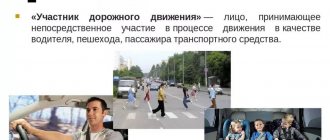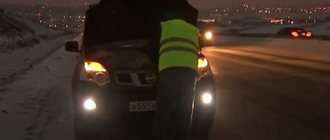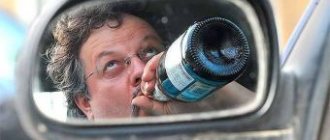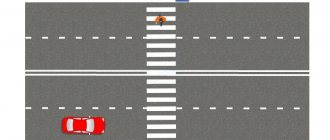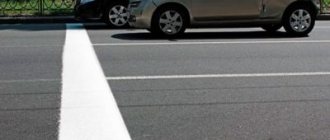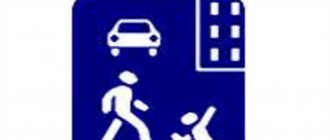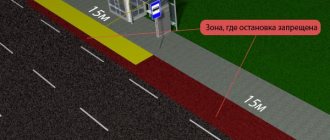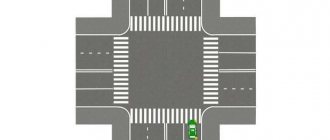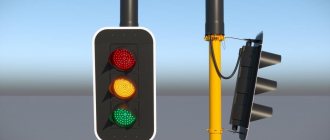There was an accident involving a tram: what to do and how to file it?
The actions of drivers in the event of an accident are described in detail in the traffic regulations, namely in paragraphs 2.5, 2.6 and paragraph 2.6.1 of the Rules. A traffic accident involving a tram is no exception, and in general, the driver must take the following actions:
- stop the machine and do not move it;
- turn on the emergency lights;
- place a warning triangle at the required distance from the car;
- do not touch or remove any fragments or debris from the damaged car and tram.
Next, drivers need to decide how they will report this accident and whether they will report it at all. After all, the tram is large, and there may be no damage at all (or new damage). Then, if the driver of the car is at fault, the accident may not be reported.
In the case when all participants require registration, you can choose either a European protocol if the conditions for it are met (see paragraph 1 of Article 11.1 of the Law on Compulsory Motor Liability Insurance), or call traffic police inspectors. Some may not know, but MTPL policies are issued for trams, just like for ordinary cars, so the likelihood that the liability of the tram driver is not insured is extremely low.
You need to fill out the European protocol form carefully and carefully so as not to make mistakes. Therefore, it will not be possible to do this quickly. In this regard, it is worth thinking about the requirements of the Traffic Rules, namely, to clear the roadway if it interferes with the movement of other vehicles.
To fulfill this requirement, it is necessary to record everything that happened in a photo or video. In this case, not only damaged vehicles should be visible, but also some stationary objects nearby, to which it will be possible to “link” later.
You should also record traces of braking, dragging or sliding on the road, the location of fragments or flying parts. Record damage to the vehicles themselves, including the direction and depth of contact marks. The more information there is about the accident, the fewer questions there will be about the guilt of the participants.
After everything is recorded, you can remove the car from the scene of the accident so that it does not interfere with traffic. It’s bad that you can’t do the same with a tram and it will remain idle on the tracks, like other trams following the same tracks.
What if the tram fled the scene?
This title sounds like the plot of some science fiction action movie, but this happens in our lives. The tram driver, in fact, may simply not feel or notice the collision with the car and continue on his way along the route.
Drivers often don’t know what to do in such a situation, but we will look at the possible options.
- You are obliged, in full compliance with traffic regulations, to stop your car at the scene of an accident and call the police. In this case, it is worth remembering or photographing the tram number and its route number, so that later you can find both the tram itself and the driver.
- If the car has a video recorder that recorded the moment of the accident, then you can go in pursuit of the tram. Catch him at the next stop and explain to the driver that there was an accident. In this case, you will not be charged with leaving the scene of the accident, but a video recording will help document the incident itself.
Both of these situations have their own subtleties. In the first case, the driver may wait a long time for the traffic police inspectors and then wait two months for the documents on the accident in order to contact the insurance company, since the inspectors will conduct an administrative investigation.
And in the second case, you may encounter inspectors who want to book the driver of the car for leaving the scene of an accident, and you will have to spend energy proving your innocence.
Area of operation of the “No Stopping” sign
This sign begins to operate from the place where it is installed . If you stop the car right in front of the sign, then no penalties will follow.
The rules also dictate that the effect of a sign prohibiting stopping applies exclusively to the side of the road where it is installed.
The duration of the sign may vary:
- to the nearest intersection;
- to the beginning or end of a populated area;
- until the “End of all restrictions zone” sign is indicated.
The sign's coverage area may also be determined by a sign indicating the length of the restriction . This means that the effect of the prohibitory sign ends after the distance reflected on the sign.
Video: Road sign 3.27 “Stopping is prohibited”
What is the fine for tram idleness in 2021?
While talking above about the consequences of an accident with a tram and the creation of obstacles to the movement of cars, we did not talk about the rail vehicles themselves. They, unlike a car, cannot go around the obstacle, which means they will have to wait until the roads are completely cleared and the accident itself is registered.
What kind of punishment awaits the driver of the car for idle time on this public transport. Unfortunately or fortunately, there is no administrative punishment for such a case. The traffic rules set out the requirements to remove a damaged vehicle from the roadway. For failure to comply with this requirement, liability is provided under Art. 12.27 of the Code of Administrative Offenses of the Russian Federation with a fine of one thousand rubles, but the tram tracks are not a roadway, which means that the tram driver will not have this administrative offense.
But the driver, if he is to blame for the accident, will be forced to pay for losses associated with the downtime of the trams, and there the amounts are much greater than a fine of 1,000 rubles. For example, for tram tracks with 2-3 routes, an hour of tram downtime in 2021 could cost about 10,000 rubles.
Exceptions to the rules
However, there are a number of exceptions, which are provided for in paragraph 87 of the administrative regulations of the traffic police. According to its wording, stopping of the above-mentioned places by traffic police officers is permitted if this measure is aimed at ensuring the safety of other drivers.
Next, paragraph 88 describes in more detail a number of exceptions to the rules when traffic police officers can stop a vehicle even in prohibited places:
- If it is necessary to stop a crime or administrative offense being committed.
- The need to regulate traffic flow.
- If the driver's movement poses a threat to the lives of other drivers and pedestrians.
If a vehicle stopped by an inspector in prohibited places causes interference to other drivers or pedestrians, then employees must ensure their safety.
Taking into account the above rules, traffic police officers have every right to demand that vehicles stop for a fee in places prohibited by the rules. However, these exceptions do not imply chaotic demands to stop, but only situations when we are talking about a violation of the rules or a threat to human life.
Who is to blame for such an accident?
In an accident with a tram, as in any other, there may be questions about who is at fault and should compensate for the damage. Unfortunately for car drivers, there are not many such situations, because the tram cannot leave the yard or overtake on oncoming traffic. Let's look at the most common controversial situations.
I was standing on the tracks and he crashed into me
A tram driver, like any other, can be distracted from the road and not have time to brake in front of a stopped car. In such a situation, there will be little controversy; the guilt of the tram driver is obvious.
But, if, for example, the driver suddenly changed lanes in front of the train, and due to the suddenly shortened distance the tram was unable to avoid a collision, then the situation may be controversial. Here, both the driver of the car and the tram can be found guilty of an accident, depending on what evidence of their innocence each of the participants in the accident provides.
If you hit the mirror
On tight city streets, the lateral space between trams and cars is reduced to a minimum, and situations are not uncommon when a tram hits a car's mirror.
And here lies one of the most common myths - supposedly the driver of the car is obliged to maintain a lateral interval to the tracks so that the tram does not hit his car. If this duty is not fulfilled, then the blame will fall on the motorist. This is not true and a myth! If the car did not move, then the driver of the rail transport will be to blame for the accident. The tram driver may not even notice the contact with the car and continue moving, thereby leaving the scene of a traffic accident.
But a more controversial situation is when the collision occurs due to the rear part of the tram being carried out in a turn. The offset warning is indicated on trams and can be 1.7–2 meters. If this interval is not observed, the driver of the car may become the culprit of an accident with the tram, because when turning, the tram cannot physically control the interval on one side, and, therefore, the driver must maintain the lateral interval, taking into account the offset of the tram.
If he deliberately rammed me
There are many videos and even compilations of accidents with trams on the Internet, in which it seems that the driver of the latter deliberately rams the car. Such a development of events cannot be excluded, but, as a rule, no one does this on purpose, and it will be almost impossible to prove the intention of the “tram driver”.
The fact is that, according to instructions, drivers of public transport, including trams, are prohibited from braking sharply, as this may harm passengers in the cabin. Let's add to this the moment of detection of the very danger of a collision and the driver's reaction time, and it turns out that supposedly trams deliberately drive into cars that violate traffic rules, but in reality this is most often not the case.
Other typical situations
There are almost no controversial situations with questions about the guilt of drivers among the remaining typical accidents with trams, so we will mention them briefly.
- Violation of priority is the most common of all situations. Not giving way to a tram is a classic. When a tram turns and it has the advantage, or when a car turns and the tram goes straight with the advantage - there are a lot of such situations.
- There are fewer cases when a tram leaves the depot and is not inferior to moving cars, but they also happen. In all these tram accidents, the fault of the traffic violator is obvious.
- An accident with a tram can also occur due to excessive speed, but not only with a car. There are cases when the tram itself exceeds the speed limit, as a result of which it can go off the rails and hit cars. In such an incident, the fact of speeding will not even have a special role, the main thing is that the railman himself caught the cars, precisely by leaving the rails, and his guilt is undeniable.
- When the flow of cars intersects with tram traffic at a controlled intersection, one of the participants in the accident, either a car or a tram, may drive through the prohibiting traffic light and an accident will occur. In such an incident, the culprit will be obvious, provided that it is known who was driving at which traffic light.
We let pedestrians pass from the tram. Clause 14.6 of traffic rules
Ust-Kamenogorsk is one of the few cities in Kazakhstan, and what about Kazakhstan, in the entire CIS, in which the tram fleet has been preserved and functions quite well. Considering the not entirely wonderful environmental situation, electric transport is very useful in terms of reducing the load on the atmosphere. And it’s convenient for passengers - trams don’t get stuck in traffic jams. It's really cold in them in winter. At least it was the last time I rode the tram many years ago.
But today we are not talking about that.
Each city has its own established traditions and norms, sometimes different from those enshrined in government documents. For example, in our city all drivers stop when the tram opens its doors to board and disembark passengers. But in Novosibirsk, during my studies (until 1993), the situation was somewhat different.
When we used Novosibirsk trams, we were always surprised why they did not open the doors for a long time when they stopped. They just stand and stand, sometimes for minutes. But one day we understood the reason for such strange, in our Ust-Kamenogorsk opinion, behavior. The stopped tram immediately opened its doors and my friend and I stepped forward onto the road. At the same time, a sharp tug on the collar pulled us back. At that same second, several cars roared past our eyes, almost hitting us! The solution turned out to be simple - in Novosibirsk, vehicle drivers did not stop and did not give way to public transport passengers (in those days, I don’t know how it is now). To avoid accidents, tram drivers did not open the doors at stops while there was a danger for passengers to get run over. Luckily for us, seeing our reckless exit, the man standing behind grabbed both of us by the scruff of the neck and pulled them back just in time.
Tram and pedestrians
What is the current situation? Let's remember how the traffic rules now sound regarding the passage of pedestrians to/from a vehicle (the same in the Russian Federation and Kazakhstan):
14.6 . The driver must give way to pedestrians walking to or from a fixed-route vehicle standing at a stopping place (from the doors), if boarding and disembarking is carried out from the roadway or from a landing area located on it.
What are the nuances and what mistakes do drivers make, especially those who received their license a long time ago:
— sometimes there is an opinion, left over from Soviet times, that if there is a landing area for pedestrians, you don’t have to give way to pedestrians. As we see, this is a wrong opinion;
— the driver must give way to pedestrians walking to the landing site for vehicle that has not yet stopped This is not true; the driver must give way to pedestrians walking towards stationary vehicle. However, from the point of view of road culture, when the tram is still approaching the stop, but pedestrians are already starting to move, it is better to give in to them. But if it didn’t work out, and they are trying to punish you, we read the letter of the rules verbatim. There is also a nuance here - from a formal point of view, if a vehicle (i.e. a tram) has closed its doors and moved off, then passengers can no longer be allowed through. Whether to do this or not is at your discretion;
- the most popular misconception is that the driver must wait until the vehicle closes the doors , and only then start driving. This picture is often observed in the city, especially when there is a red traffic light ahead and the tram is simply standing with its doors open and waiting for customers, and especially vigilant drivers stand with it. According to clause 14.6. There is no need to wait for the doors to close. What is important here is a correct understanding of the term “give way” - “Give way (do not interfere)” is a requirement that means that a road user must not start, resume or continue moving, or carry out any maneuver if this may force other road users to having an advantage over him, change the direction of movement or speed. Specifically in our situation, if you drove in front of open doors when no one was getting out or walking towards the vehicle, then you did not interfere with it, which means you did not violate the traffic rules.
I would like to note right away that I am not a lawyer, I could be mistaken, so if anyone has a different interpretation of this point of the rules, I am happy to discuss it. Write in the comments.
How to prove the innocence of a car driver?
In controversial situations, when they try to pin the blame for an accident on the driver of the car, it is necessary to prove one’s innocence. This can be done using various arguments that will confirm that you do not have a traffic violation, for example:
- DVR recording;
- witness's testimonies;
- recordings from CCTV cameras;
- photos;
- expert opinion.
Let's talk about each of them in more detail.
A DVR recording is one of the simplest and most effective evidence of your innocence. The video will show which vehicle was moving, which one was standing, who violated the traffic rules and how the collision occurred. At the same time, the recorder may not be in your car, but in those passing nearby or on a tram. It is important that the video is saved and not overwritten.
Witness testimony can also help prove your innocence. It is best to look for witnesses immediately at the scene of the accident. This could, of course, be tram passengers or people waiting for the tram at the stop, as well as other eyewitnesses of the accident.
If witnesses have been found, then their contact information must be obtained. At a minimum, a phone number and full name, but better yet an address so that they can be found more easily. It is better to immediately report the obtained data to the traffic police inspectors so that they indicate the data of the witnesses in the documents. If it was not immediately possible to find eyewitnesses, but later they were found, for example, through social networks, then you will need to petition the traffic police to question them as witnesses.
Although witnesses are warned about the liability for giving false testimony, this does not always save them from “false” eyewitnesses who speak in favor of one of the participants in the accident. Therefore, both traffic police officers and courts most often give preference to information methods of proof.
An accident with a tram can be recorded not only on a DVR camera, but also on street surveillance cameras, city or private, installed on buildings and other objects. It is advisable to find them immediately after the accident in order to request a video recording from traffic police inspectors, but it is also possible after. The main thing you need to know is that inspectors will be reluctant and unwilling to do this, so it is in your interests to find the cameras yourself, find out what kind of organization it is and insist on requesting this video. Also, immediately after discovering such cameras, ask their owners to save the video for you, you can thank them in rubles.
In St. Petersburg, for example, there is a city video surveillance system, the cameras of which are located throughout the city. After an accident, you can call this service and find out if there is a camera at the site of your accident. If there is such a camera, then you can leave a request to save the video recording, which the traffic police inspector will then request.
It is also important to take photographs of the accident scene and vehicle damage. The location of the car and the tram should be recorded; it is advisable to take many photographs, from different sides, with reference to stationary objects. Photographs of the damage should show the beginning, end and depth of the contact mark. If there are fragments of any parts, then take photographs of their location on the road.
The photographs you take from the scene of the accident can be independent evidence indicating your innocence. But most often they are used to conduct an examination (traceological) in which the expert, if possible, will determine the mechanism of the accident and indicate who was moving and how at the time of the collision.
The above list of evidence, of course, is not exhaustive; you can use other ways to prove your innocence.
Important note!
- This article describes the basic principles of how legislation works. Meanwhile, in judicial practice everything depends on specific circumstances.
- In 96% of all cases there are subtleties that can affect the outcome of the entire case.
- Therefore, we recommend entrusting the matter to professionals who will study your business and select the right winning strategy.
The TonkostiDTP website employs professional road accident lawyers with experience in all major types of disputes (MTPL, guilt, administrative penalties).
Ask a lawyer
or get a free consultation by calling the hotline: 8.
Effect of “No Stopping” signs
Immediately after a stop sign, stopping traffic will entail administrative liability. Its effect is not infinite; the limit is the nearest intersection, the border of a populated area or a sign that cancels all restrictions. Also, a prohibitory sign is sometimes accompanied by a sign with a specific indication of the distance to which its effect extends.
You can stand directly in front of the stop sign.
But the requirements of the sign can sometimes be neglected. The following have this right:
- route transport;
- metered taxis;
- drivers with disabilities (in this case, the car must be equipped accordingly and have a sign warning that a disabled person or a person transporting him is driving).
Attention! For disabled people (even if their car is suitably equipped and equipped with identification signs), the prohibition does not apply only if the stop prohibition sign is supplemented with an appropriate plate.
The culprit is the tram driver - how to get compensation?
The situation with full compensation for damage also works in the opposite direction, when the tram driver is to blame for the accident. Having received insurance compensation from the insurer, you can recover the missing difference from the organization carrying out the transportation.
First you need to contact your insurance company. To your own, if the conditions for direct compensation of losses are met, and to the tram insurance company, if the conditions for the PPV are not met. Then everything is standard:
- submission of a complete set of documents,
- providing the vehicle for inspection to the insurer,
- waiting for payment or referral for repairs,
- in case of disagreement, a corresponding application is submitted to the insurance company,
- if your requirements have not been satisfied, then further contact the financial ombudsman,
- the last stage is the trial.
You can file against both the insurer and the culprit at once (in the case of a tram, against the organization, and the tram driver can be brought in by a third party).
I am a tram passenger and was injured - what should I do?
First of all, you need to record that you were injured in this accident, that is, you need to inform the police or drivers that you were injured. After this, depending on the degree of harm to your health, the person responsible for the accident will be held administratively or even criminally liable, and you will receive documents regarding this accident.
After this, you can apply for payments. Compensation in this case may vary, but not only in amounts, but also on grounds.
The fact is that a tram passenger can claim several payments at once. Of course, he will receive a payment under OSGOP. This is mandatory insurance for the carrier's civil liability. Further, the victim will be able to claim payment under compulsory motor liability insurance from the insurance company of the driver of the car, and it does not matter whether the driver of the car is at fault or not. Owners of a source of increased danger are jointly and severally liable to third parties. This means that both the tram and the driver of the car will be responsible for harm to health. Payment under compulsory motor liability insurance can be difficult due to ambiguous judicial practice, but many decisions where recovery was made under this scheme survived in the cassation courts.
Insurance payments will be calculated according to the table, you can look at it and estimate how much they will pay for this or that damage. The only difference is in the insured amount, for OSGOP – 2,000,000 rubles, and for OSAGO – 500,000 rubles.
In addition to insurance payments, the injured tram passenger will be able to receive compensation for moral damage. Again twice. From the driver of the car and from the organization that carried out the transportation.
Where is stopping prohibited?
Places where you cannot stop and leave your car (stopping traffic is regarded as parking if the car does not move for more than five minutes) include:
- The last five meters before the crossing and the crossing itself . A car parked at the crossing will not allow you to cross the road calmly, and a car parked in front of it interferes with your view. The person driving the next car in the same direction is forced to go around the stopped vehicle, but there is a high risk that he will run over the person entering the intersection, because the pedestrian also will not see the threat from the stopped vehicle. If you absolutely must stop, it is better to do so immediately after the crossing;
- Tram rails and surrounding area . This threatens to disrupt public transport schedules and cause traffic jams. There is no way for a tram to get around a car standing on the rails.
- Crossroads and surrounding area (5 m) . It will not be a violation if a standing car is separated from the side road by a continuous strip of markings.
- Special bands . Mopeds, bicycles and public transport have the right to be there.
- Areas immediately in front of traffic lights and signs where they will be blocked by a stationary vehicle.
- Pedestrian areas.
- Dangerous turns and the surrounding area , as well as elevation changes, where visibility on the road is less than one hundred meters - this creates a risk of accident for passing cars. It's better to leave the car on the side of the road.
- Stops intended for taxi drivers and minibus drivers . Please note: parking is prohibited there. But you can stop next to a public stop (less than 15 meters) in order to drop off or pick up a travel companion.
- Tunnels.
- No parking zone.
- Parking for disabled drivers.
- Areas where a parked vehicle will block the exit or exit of a building/area.
- Areas adjacent to the crossing over rail tracks (50 m) and the crossing itself . This disturbs all road users and prevents those traveling from noticing the train.
- The main road marked with the appropriate sign - if the case occurs outside populated areas.
- Lawns (fenced off areas of land without asphalt covering, intended for landscaping).
- Bridges and overpasses , areas directly under them. On bridges you have to put up with limited space and increased surface load. If the driver realizes that he will have to stop, it is better to do this directly in front of or immediately behind a bridge or overpass. Sometimes you can go straight at them, but only if the signs and markings allow it. You will also have to stop on the bridge if required by the traffic inspector.
Of course, it is not always possible to comply with the ban. However, the car owner himself is obliged to do everything to remove the broken car from the restricted area as quickly as possible.
Judicial practice regarding accidents with trams
- Decision of the St. Petersburg City Court in case No. 7-367/2020 dated March 10, 2021. The tram driver was found guilty of violating clause 9.10 of the traffic rules and was prosecuted under Part 1 of Art. 12.15 Code of Administrative Offenses of the Russian Federation. He was unable to prove his innocence in an accident where a lady in a car got ahead of a tram, changed lanes onto the tram tracks and began to turn around, and the tram caught up with her.
- Decision of the St. Petersburg City Court in case No. 7-191/19 of January 29, 2021. The court listened to the arguments of the tram driver that his guilt in violating the distance had not been proven, and the circumstances of the accident had not been fully and comprehensively investigated. As a result, his complaint against the traffic police inspector’s decision was returned to the lower court for a new consideration.
- Decision of the Supreme Court of the Republic of Tatarstan in case No. 77-1039/2020 dated July 22, 2021. The tram driver was towing another car, which was in front of the train, as a result of which he did not notice the car in time and was unable to prevent the accident. The court found him guilty under Part 1 of Art. 12.15 Code of Administrative Offenses of the Russian Federation. The arguments of the complaint were not taken into account by the court.
What are the traffic rules for trams?
Let us recall the basic rules for tram drivers.
- At controlled intersections, when the traffic light signal permits, the tram driver must give way to an oncoming tram moving straight or to the right.
- If the instructions of the traffic controller or traffic lights allow both the tram and cars to travel, then the tram has priority. However, if the tram has an additional light with the main red or yellow light on, then it must give way to vehicles moving from other directions.
- At uncontrolled intersections, the tram has an advantage over both passing and oncoming cars if they are on an equivalent road.
- At the intersection of equivalent roads, the tram has priority over trackless vehicles.
The tram has an advantage over cars and outside intersections where tram tracks cross the roadway, except when leaving the depot.
